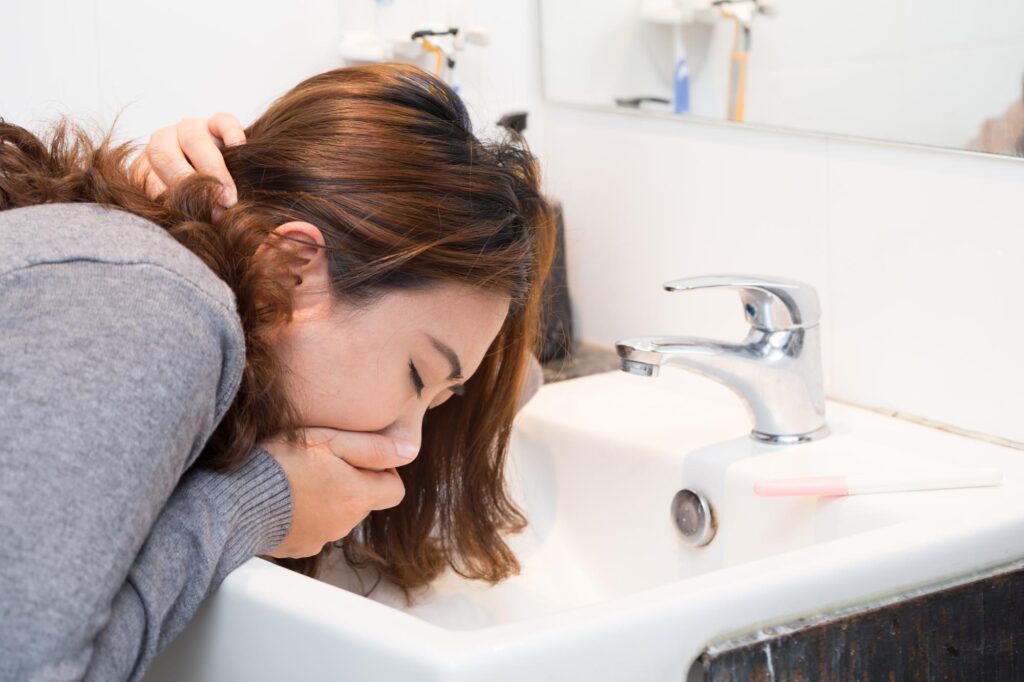Cannabinoid Hyperemesis Syndrome (CHS) is a complex medical condition that affects long-term cannabis users, causing severe episodes of nausea, vomiting, and abdominal pain. This condition can be particularly challenging for women, as its symptoms often mirror other health issues specific to female biology.
Women face unique challenges in receiving an accurate CHS diagnosis due to overlapping symptoms with conditions like pregnancy-related morning sickness, endometriosis, and other gynecological disorders. The medical community has historically underdiagnosed CHS in women, making awareness crucial for proper treatment.
This guide explores the essential aspects of CHS that every woman should understand:
- Key symptoms and warning signs
- Diagnostic procedures specific to women
- Treatment options and management strategies
- Prevention methods and lifestyle modifications
Understanding CHS empowers you to make informed decisions about your health and cannabis use, ensuring timely medical intervention when needed.
Understanding Cannabinoid Hyperemesis Syndrome (CHS)
Cannabinoid Hyperemesis Syndrome (CHS) is a condition that affects long-term cannabis users. It is characterized by recurring episodes of severe nausea, vomiting, and abdominal pain. These symptoms typically occur in cycles, with periods of intense illness followed by symptom-free intervals.
Key Symptoms of Cannabinoid Hyperemesis Syndrome:
- Severe vomiting episodes lasting 24-48 hours
- Intense abdominal pain centered in the upper middle part of the abdomen
- Relief from symptoms through hot showers or baths
- Symptoms return when hot water exposure ends
How CHS Differs from Cyclic Vomiting Syndrome (CVS)
CHS is often confused with Cyclic Vomiting Syndrome (CVS), but there are several key differences between the two conditions:
- CHS occurs only in cannabis users
- Hot water relief is unique to CHS
- CVS patients respond well to standard anti-nausea medications
- CHS symptoms resolve when cannabis use stops
Phases of Cannabinoid Hyperemesis Syndrome
Cannabinoid Hyperemesis Syndrome progresses through three distinct phases:
- Prodromal Phase: Mild morning nausea and stomach discomfort
- Hyperemetic Phase: Intense vomiting, abdominal pain, and compulsive bathing
- Recovery Phase: Symptom resolution after stopping cannabis use
If cannabis use continues, these symptoms can persist for years, with episodes becoming more frequent and severe over time.
Why Women Need to Know About CHS
Recent studies indicate that while CHS affects both genders, women face unique diagnostic challenges. Research shows a rising trend of CHS cases among women aged 18-35, particularly in states with legalized cannabis use.
Women experience several health conditions that share symptoms with CHS:
- Pregnancy-related morning sickness
- Hyperemesis gravidarum
- Endometriosis
- Ovarian cysts
- Menstrual-related nausea
These overlapping symptoms create diagnostic complexities for healthcare providers. A woman experiencing severe cyclical vomiting might receive multiple misdiagnoses before CHS is identified, delaying proper treatment.
The medical community now recognizes the importance of including CHS in differential diagnosis for women who use cannabis and present with unexplained vomiting. This awareness becomes critical as women’s cannabis use patterns shift, with data showing increased consumption rates among female users.
Understanding CHS symptoms helps women make informed decisions about their cannabis use and seek appropriate medical care when needed. Early recognition prevents unnecessary medical procedures and ensures faster access to effective treatment options.
In cases where women are struggling with substance use disorders due to their cannabis use, specialized treatment programs such as those offered by Revelare Recovery Center can provide the necessary support. They offer behavioral health and addiction treatment programs focused on women’s unique needs in Atlanta, GA.
Causes and Risk Factors Specific to Women
The primary trigger for CHS development in women stems from regular, heavy cannabis use – typically daily consumption spanning several months or years. Research indicates that THC accumulation in the body’s fat cells plays a crucial role, with women’s higher body fat percentage potentially increasing their susceptibility.
Women face unique risk factors that can complicate CHS diagnosis and treatment:
- Pre-existing Medical Conditions: Type 1 diabetes can create overlapping symptoms through diabetic gastroparesis, making diagnosis challenging
- Hormonal Influences: Estrogen levels affect cannabis metabolism, potentially intensifying CHS symptoms during different menstrual cycle phases
- Genetic Variations: Some women carry genetic polymorphisms affecting cannabinoid receptor function
- Body Composition: Higher body fat percentages in women may lead to increased THC storage
Additional risk factors include:
- Using high-potency cannabis products
- Combining cannabis with other medications
- History of gastrointestinal disorders
- Stress-related conditions that might trigger symptom onset
The interaction between female physiology and cannabis creates distinct challenges in identifying and managing CHS, particularly when multiple health conditions are present.
Recognizing Symptoms and Clinical Features in Women with Cannabinoid Hyperemesis Syndrome
Women experiencing CHS typically present with distinct symptoms that occur in cycles:
1. Intense Vomiting Episodes
- Multiple episodes per hour during acute phase
- Can last 24-48 hours without intervention
- Clear or bile-colored vomit
2. Severe Abdominal Pain
- Sharp, cramping sensation in upper abdomen
- Pain often centered around navel area
- Intensity fluctuates throughout episodes
A hallmark sign of Cannabinoid Hyperemesis Syndrome is the compulsive hot bathing behavior. You might find yourself:
- Taking multiple hot showers daily
- Spending hours in hot baths
- Experiencing temporary relief only while in hot water
Red Flag Symptoms:
- Weight loss exceeding 5 pounds during episodes
- Inability to keep fluids down for 24+ hours
- Dark or decreased urine output
- Severe abdominal tenderness
- Racing heartbeat or dizziness when standing
These symptoms typically appear in a three-phase pattern: prodromal (early warning), hyperemetic (intense vomiting), and recovery. Each phase presents unique challenges requiring different management approaches.
Diagnostic Procedures for Women Experiencing Chronic Vomiting Related to Cannabis Use
Diagnosing Cannabinoid Hyperemesis Syndrome presents unique challenges due to its symptom similarities with other gastrointestinal conditions. Medical professionals typically follow a systematic approach:
1. Initial Screening Tests:
- Complete blood count
- Comprehensive metabolic panel
- Pregnancy test
- Urine drug screening for cannabis
2. Advanced Diagnostic Procedures:
- Abdominal ultrasound to examine liver, gallbladder, and pancreas
- Upper endoscopy to rule out structural abnormalities
- Gastric emptying study to check for gastroparesis
The diagnosis often relies on three key criteria:
- Long-term cannabis use (usually weekly for >1 year)
- Relief of symptoms with hot showers/baths
- Resolution of symptoms after cannabis cessation
Your healthcare provider might request additional tests based on your specific symptoms. Women with CHS symptoms can experience delayed diagnosis due to overlapping conditions like:
- Cyclic Vomiting Syndrome (CVS)
- Hyperemesis gravidarum
- Gastroparesis
- Gallbladder disease
A detailed medical history, including cannabis use patterns, helps differentiate CHS from these conditions.
Treatment Options and Management Strategies for Women with Cannabinoid Hyperemesis Syndrome
The most effective treatment for CHS requires complete cessation of marijuana use. Research shows symptoms typically resolve within 7-10 days of stopping cannabis consumption, though recovery time varies among individuals.
Primary Treatment Approaches:
- Immediate discontinuation of all cannabis products
- IV fluid therapy to combat dehydration
- Anti-nausea medications (with variable effectiveness)
- Hot showers or baths for temporary symptom relief
Alternative Treatment Methods:
- Topical capsaicin cream application to the abdomen
- Temperature regulation techniques
- Stress reduction practices
- Electrolyte replacement therapy
Many traditional anti-nausea medications prove ineffective for CHS patients. Medical professionals often recommend a combination of treatments tailored to each woman’s specific symptoms and severity. Hospital admission becomes necessary in severe cases where dehydration poses significant health risks.
Supportive Care Measures:
- Regular monitoring of vital signs
- Nutritional support during recovery
- Prevention of dehydration through IV fluids
- Management of associated anxiety symptoms
The duration and intensity of treatment depend on factors like length of cannabis use, frequency of consumption, and individual physiological responses.
Preventive Measures and Lifestyle Recommendations for Women at Risk of Developing Cannabinoid Hyperemesis Syndrome
Understanding your personal risk for CHS starts with recognizing patterns in your cannabis use. Women who use cannabis daily or multiple times per day face higher risks of developing CHS symptoms.
Key Prevention Strategies:
- Track your cannabis consumption patterns using a digital diary or wellness app
- Set specific limits on daily cannabis intake
- Take regular tolerance breaks from cannabis use
- Stay hydrated and maintain regular meal schedules
- Monitor early physical responses like mild nausea or stomach discomfort
Early Warning Signs to Watch:
- Mild morning nausea that improves with hot showers
- Unexplained periodic stomach pain
- Changes in appetite
- Increased sensitivity to certain foods
- Subtle shifts in digestion patterns
Creating a balanced lifestyle helps reduce CHS risk. Incorporate stress-management techniques like meditation, exercise, or therapy as alternatives to cannabis use. Pay attention to your body’s signals – any new digestive symptoms warrant a conversation with your healthcare provider, especially if you use cannabis regularly.
When to Seek Medical Help: Warning Signs for Women With Suspected Cannabinoid Hyperemesis Syndrome
Recognizing critical warning signs can prevent severe complications from Cannabinoid Hyperemesis Syndrome. Seek immediate medical attention if you experience:
- Vomiting episodes lasting longer than 24 hours
- Inability to keep liquids down for 12+ hours
- Severe, persistent abdominal pain
- Weight loss exceeding 5 pounds during episodes
- Dark or decreased urine output
Signs of dangerous dehydration include:
- Extreme thirst
- Dry mouth and cracked lips
- Dizziness upon standing
- Rapid heartbeat
- Confusion or disorientation
Untreated CHS can lead to serious health complications:
- Severe electrolyte imbalances
- Vitamin B1 (thiamine) deficiency
- Esophageal tears from forceful vomiting
- Kidney problems
- Malnutrition
Your healthcare provider might recommend hospitalization for IV fluids, electrolyte replacement, and monitoring if symptoms become severe. Early intervention prevents the development of life-threatening complications and supports faster recovery.
Conclusion
Cannabinoid Hyperemesis Syndrome can significantly impact your health and daily life. Recognizing the signs and seeking professional help early makes a crucial difference in your recovery journey. You don’t have to face this challenge alone.
At Revelare Recovery, our dedicated team understands the unique needs of women struggling with cannabis use and its complications. We provide comprehensive, personalized care to help you:
- Break free from cannabis dependency
- Manage CHS symptoms effectively
- Address underlying behavioral health concerns
- Develop healthy coping strategies
Our Intensive Outpatient Program (IOP) is designed to offer personalized mental health and substance abuse treatment for women.
Ready to take the first step toward recovery? Our compassionate specialists at Revelare Recovery’s Atlanta center are here to support your journey to wellness. Contact us today to learn how our women-focused treatment programs can help you reclaim your health and well-being. Remember, you don’t have to navigate this path alone; we’re here to help you every step of the way.

